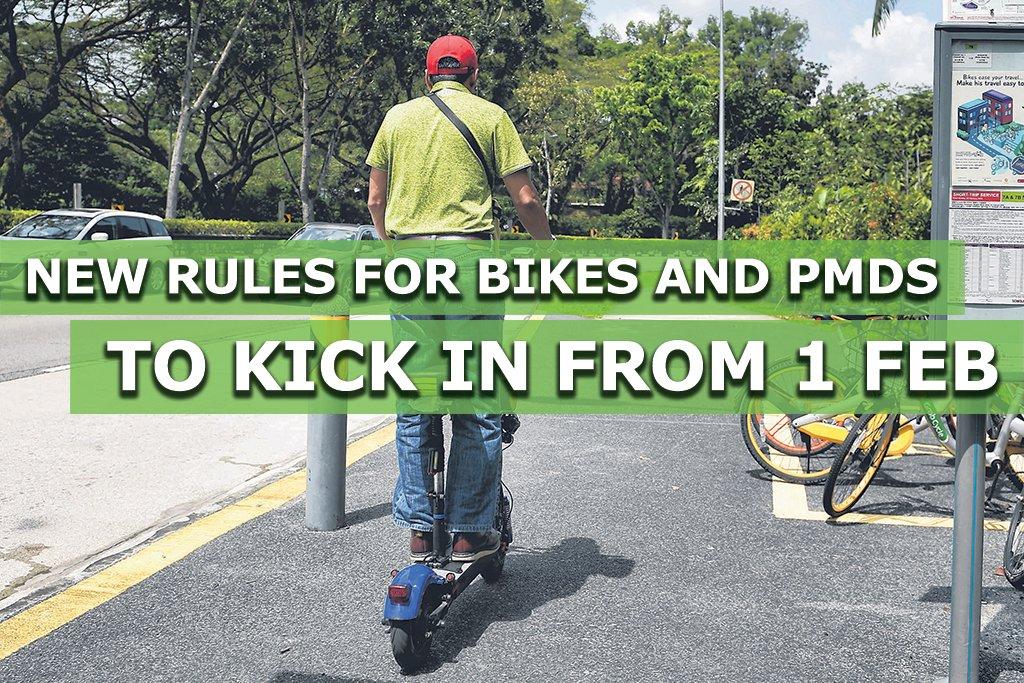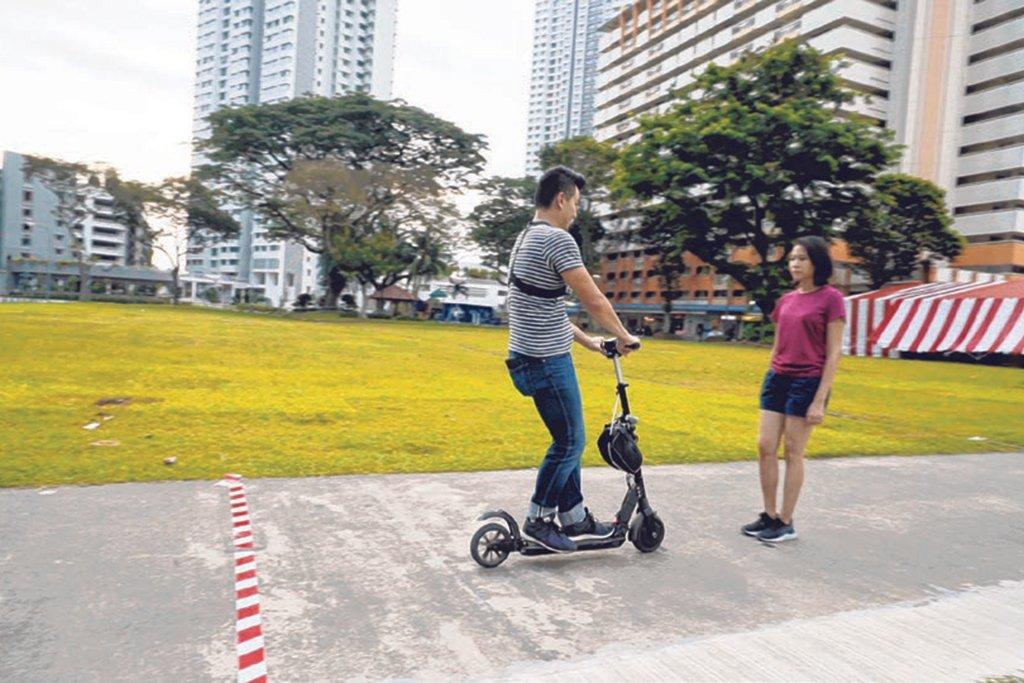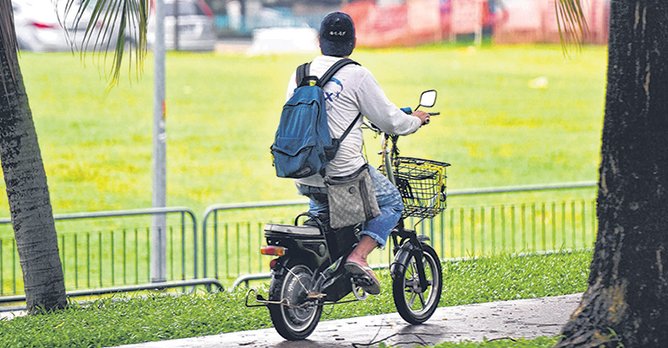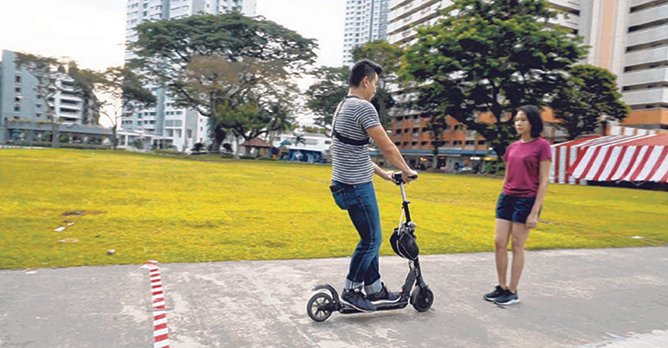Lower speed limit and other new rules for bikes and PMDs to kick in from 1 Feb
18 Jan 2019|1,219 views
Cyclists and users of Personal Mobility Devices (PMD) will no longer be able to ride at speeds above 10km/h on footpaths from 1 February onwards, the Land Transport Authority (LTA) said on Friday (18 January). In addition, cyclists and PMD users will have to stop and look out for vehicles at road crossings. All cyclists will have to wear helmets when riding on roads.
Meanwhile, personal mobility aids such as motorised wheelchairs and mobility scooters will be required to have a maximum device speed of 10km/h.
The LTA said in a statement, "These rules are part of ongoing efforts to foster greater rider responsibility and encourage safe sharing of our paths and roads." The rules were first announced by the Government in September last year, after it accepted the recommendations of the Active Mobility Advisory Panel.
While the changes were largely accepted by the public, the revised speed limit on footpaths has sparked a robust debate. Both cyclists and users of PMD questioned the practicality of getting them to travel at what was essentially just a fast running pace.
Under previous rules, cyclists and PMD users can ride on footpaths at a speed of up to 15km/h. But LTA said lowering the speed limit to 10km/h would allow all path users more time to react to unforeseen circumstances, thus reducing the risk of accidents and the severity of injuries should they happen.
In terms of the mandatory use of helmets by cyclists, LTA said this rule is for the cyclists' own safety as they are more vulnerable compared to drivers and riders of other vehicles on the road.
Regarding the 'stop and look' rule, motorists will also have to slow down and look out for people crossing the road. LTA said this will help to improve the predictability of behaviour of all users and provide both device users and motorists more reaction time.
Anyone caught flouting any of the three rules listed above can be fined up to $1,000 and/or jailed up to three months upon conviction for the first offence. LTA said the maximum device speed of 10km/h for motorised personal mobility aids will safeguard the use of such devices for only those who genuinely need them, and prevent the abuse and modifications of such device to circumvent PMD regulations.
Anyone convicted of using a non-compliant version of such devices on public paths can be fined up to $5,000 and/or jailed up to three months for the first offence. Retailers who display or advertise non-compliant personal mobility aids can be fined up to $1,000 and/or jailed up to three months for the first offence.
Cyclists and users of Personal Mobility Devices (PMD) will no longer be able to ride at speeds above 10km/h on footpaths from 1 February onwards, the Land Transport Authority (LTA) said on Friday (18 January). In addition, cyclists and PMD users will have to stop and look out for vehicles at road crossings. All cyclists will have to wear helmets when riding on roads.
Meanwhile, personal mobility aids such as motorised wheelchairs and mobility scooters will be required to have a maximum device speed of 10km/h.
The LTA said in a statement, "These rules are part of ongoing efforts to foster greater rider responsibility and encourage safe sharing of our paths and roads." The rules were first announced by the Government in September last year, after it accepted the recommendations of the Active Mobility Advisory Panel.
While the changes were largely accepted by the public, the revised speed limit on footpaths has sparked a robust debate. Both cyclists and users of PMD questioned the practicality of getting them to travel at what was essentially just a fast running pace.
Under previous rules, cyclists and PMD users can ride on footpaths at a speed of up to 15km/h. But LTA said lowering the speed limit to 10km/h would allow all path users more time to react to unforeseen circumstances, thus reducing the risk of accidents and the severity of injuries should they happen.
In terms of the mandatory use of helmets by cyclists, LTA said this rule is for the cyclists' own safety as they are more vulnerable compared to drivers and riders of other vehicles on the road.
Regarding the 'stop and look' rule, motorists will also have to slow down and look out for people crossing the road. LTA said this will help to improve the predictability of behaviour of all users and provide both device users and motorists more reaction time.
Anyone caught flouting any of the three rules listed above can be fined up to $1,000 and/or jailed up to three months upon conviction for the first offence. LTA said the maximum device speed of 10km/h for motorised personal mobility aids will safeguard the use of such devices for only those who genuinely need them, and prevent the abuse and modifications of such device to circumvent PMD regulations.
Anyone convicted of using a non-compliant version of such devices on public paths can be fined up to $5,000 and/or jailed up to three months for the first offence. Retailers who display or advertise non-compliant personal mobility aids can be fined up to $1,000 and/or jailed up to three months for the first offence.
Latest COE Prices
April 2025 | 2nd BIDDING
NEXT TENDER: 07 May 2025
CAT A$99,500
CAT B$117,003
CAT C$65,001
CAT E$118,001
View Full Results Thank You For Your Subscription.





















